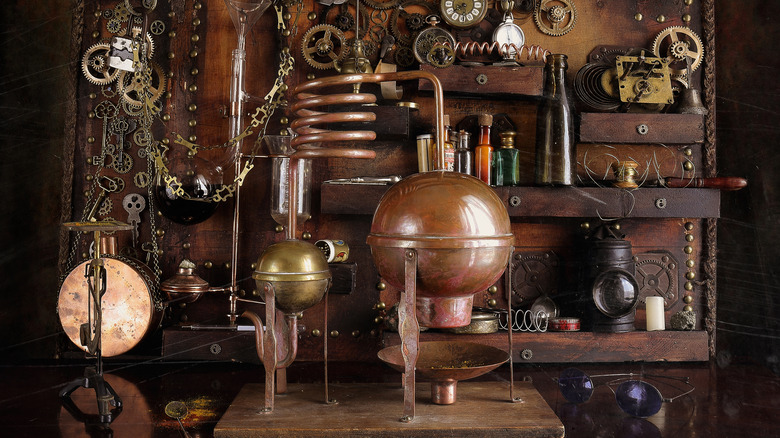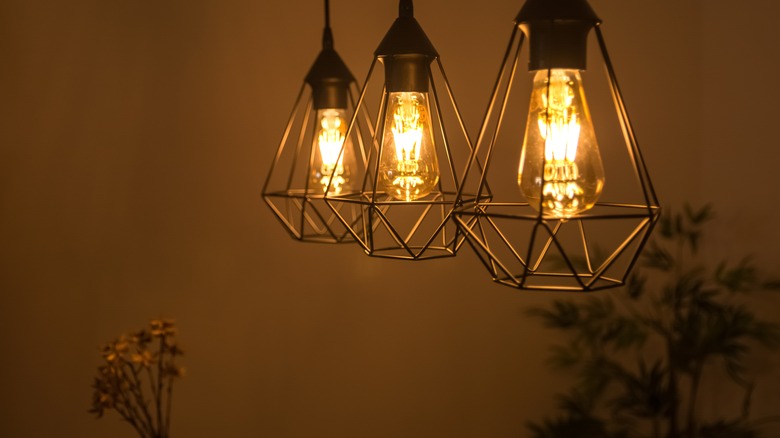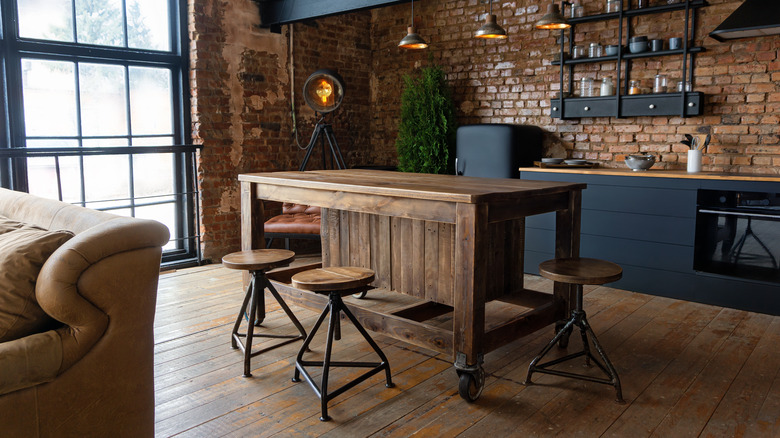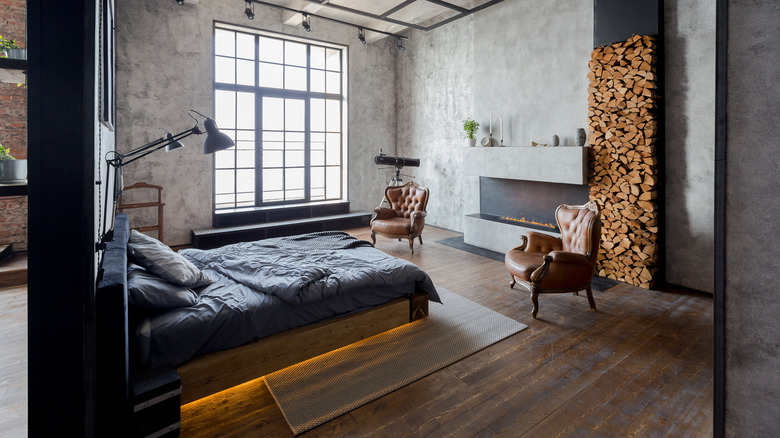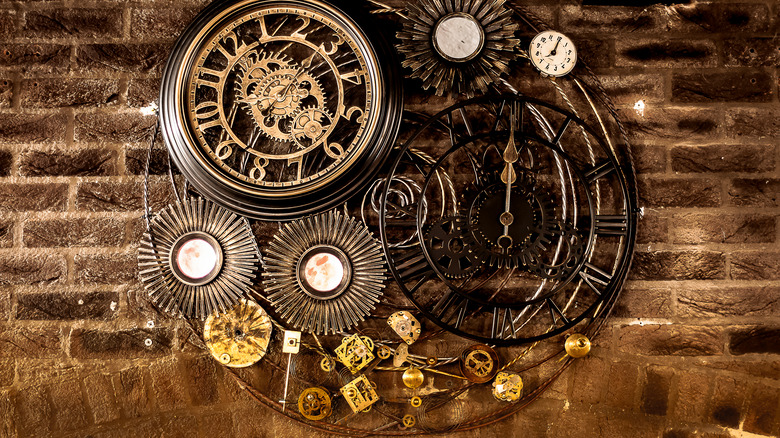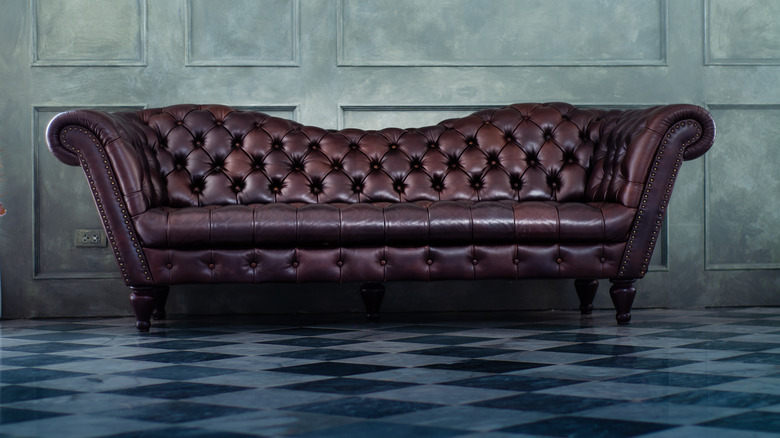5 Classy Ways To Incorporate Steampunk Into Your Home Decor
Steampunk style, marked by its industrial accents and a hint of Victorian glamour, is an eclectic style that speaks to both the past and the future, according to Foyr. It's a style that has trickled through fashion, cosplay culture, art, and décor, pulling inspiration from early science fiction writers like H.G. Wells and Jules Verne, as well the trappings of Victorian luxury and industry. Steampunk also draws from steamship voyages across the Atlantic, early train travel, and exploration.
This mix of elements leads to a décor style that embraces a wealth of rich materials, including leather, copper, iron, and tweed, as well as an abundance of accents related to industrial-age travel, science, and leisure. If you are looking for a way to bring steampunk style into your home, either on its own or by mixing elements in your existing décor, several key elements will instantly transform your space into the antique yet futuristic style of your dreams.
1. Vintage lighting
If you don't know where to start, the lighting in your home is an excellent place to consider adding a touch of steampunk style to your space. Because most lighting already implements materials like brass, wrought iron, and steel, many fixtures at all price points fit well within the steampunk style, particularly ones that highlight Edison-style bulbs. These bulbs immediately evoke the early days of electric lighting and combine well with simple fixtures to add a touch of the past.
Other lighting choices that mesh well with steampunk décor include lamps and sconces made of industrial materials like metal pipe and wrought iron, as well as touches of Victorian stained glass that add some glamour, per Foyr. Numerous retailers offer vintage industrial-age reproduction fixtures and lamps. According to Timber & Tea (via YouTube), you can even make your own steampunk-themed light fixture from a light kit and metal piping.
2. Industrial materials meet luxury
Steampunk décor is all about materials, including rustic elements like natural wood and brick, as well as man-made elements straight from the Victorian industrial age, like wrought iron, brass, and steel. These materials combine with soft materials like velvets, rich leathers, and tweeds to round out steampunk décor. Imagine the fabrics you might find decking out the interior of a turn-of-the-century luxury sleeper car. Or in the book-lined study of a wealthy industrial baron or ship's captain.
To add steampunk elements to your home, find ways to bring in textures and materials that play off of differences and variations. Steampunk style is both a nod to plush Victorian luxury and 19th-century industry, so placing things like metal pipe and brass accents next to sumptuous velvet in rich colors is an excellent way to achieve steampunk style (via Foyr). Impressive Interior Design suggests juxtaposing different textiles, like leather and lace, which combine feminine and masculine vibes.
3. Rich neutrals
Steampunk style embraces a number of darker, richer colors, including deeper neutral shades like chocolate brown, slate gray, and black. These are often accompanied by darker jewel tones like forest green, burnt orange, and burgundy. Many of the colors that inspire steampunk décor are taken from the elements that make it up, so look for a lot of metallic grays and charcoals on the cooler side and coppers and brass on the warmer. According to The Steampunk Explorer, shades of brown and deep orange are the most popular steampunk shades.
Opt for deeper, darker colors in a neutral vein when incorporating steampunk style into your space. These neutrals not only complement more industrial-style furniture and décor pieces but set a neutral background for interesting steampunk-inspired art and accents. If you are interested in adding a little more color, select more muddy and muted shades of colors like pink, mint, and aqua with a dusty Victorian attic feel. Rich, antique florals are a way to bring in some period-appropriate pattern, like pinstripes or plaid.
4. Mechanical accents
Steampunk décor is all about the accents. They take their inspiration from Victorian science machinery, antique clocks, vintage cameras, exploration tools, and old-world travel. Popular elements include gears, levers, and other machinery pieces used in new and decorative ways. Vintage technology is popular, including cameras, radios, and sewing machines, as are things related to travel and exploration, like maps, globes, compasses, and telescopes.
Like many vintage-inspired eclectic styles, steampunk is made for repurposing common objects in new ways. Rhythm of the Home offers some excellent tips on finding or DIYing new things made from old, including modifying and adapting antique pieces and materials to make them useful to modern homes. Pieces of the past, however utilitarian they once, can be assembled to create works of art and décor that reflect this unique style. Consider retrofitting an antique victrola to play LPs or using a well-used steamer trunk as a coffee table or bench.
5. Old meets new
As a style rooted in juxtapositions, steampunk is all about melding the old and the new. Steampunk style has its roots in a Victorian vision of the future, in which the heights of industry and technology were regaled and celebrated while still being rooted in the trappings of the 19th century. This manifests as an emphasis on travel developments like the steam engine, hot-air balloons, ships, and zeppelins.
As such, steampunk interiors often seem both antique and new at the same time, incorporating items like leather vintage Chesterfield sofas and Victorian maps along with modern industrial elements like metal pipe shelving and technological innovations. Steampunk spaces have an old-world feel but with a progressive, modern twist that is rooted completely in its emphasis on industry and technology. This extends to modern technology like speakers, laptops, and television sets, which offer a number of opportunities to disguise their very 21st-century trappings inside 19th-century casings (via All About Steampunk.)
